the 2007 Abstract Presentations - Wound Healing Society
the 2007 Abstract Presentations - Wound Healing Society
the 2007 Abstract Presentations - Wound Healing Society
Create successful ePaper yourself
Turn your PDF publications into a flip-book with our unique Google optimized e-Paper software.
<strong>Abstract</strong>s<br />
145<br />
FAT-DERIVED STROMAL CELL-PROMOTED WOUND<br />
HEALING<br />
S.P. Schmidt 1,2 , M. Evancho-Chapman 1,2 , W.I. Horne 1 , E.D. Boland 3<br />
1 BioMedical Research Associates, Inc., Akron, OH USA,<br />
2 Summa Health System, Akron, OH USA,<br />
3 Tissue Genesis, Inc., Honolulu, HI USA<br />
Transplantation of an inoculum of autologous cells involved in <strong>the</strong> orchestration<br />
of wound healing into a nonhealing chronic wound bed may jump-start <strong>the</strong><br />
healing process. The objective of this study was to evaluate <strong>the</strong> use of adiposederived<br />
stromal cells for this purpose. Using a swine full thickness dermal<br />
wound healing model, standard parameters of wound healing were compared<br />
between (1) wounds treated with an inoculum of autologous adipose tissuederived<br />
stromal cells dispersed into <strong>the</strong> collagen portion of a collagen/cellulose<br />
primary dressing (Promogran) that was placed cell/collagen side down into <strong>the</strong><br />
wound bed and <strong>the</strong>n covered with Allevyn, (2) wounds treated with Promogran<br />
with no cells added covered with Allevyn and (3) wounds treated with Allevyn<br />
dressings alone. <strong>Wound</strong> healing progressed in an orderly manner in all wounds.<br />
There was no evidence of infection, ery<strong>the</strong>ma or edema in any of <strong>the</strong> wound<br />
beds at any time of evaluation ei<strong>the</strong>r based upon gross or histological<br />
observations. Exudate volumes were normal in wounds from all study groups.<br />
Re-epi<strong>the</strong>lialization was first observed at Day 11 in <strong>the</strong> cell treated group but by<br />
Day 16 re-epi<strong>the</strong>lialization was evident in biopsies obtained from all treatment<br />
groups. Statistical analyses of ranks of collagen organization and neovascularity<br />
revealed no significant differences in organization between <strong>the</strong> three<br />
treatment groups at any time point of analysis. There was no evidence that <strong>the</strong><br />
presence of <strong>the</strong> stromal-derived cells unduly influenced inflammatory processes.<br />
In conclusion, wounds dressed with Promogran containing an inoculum of<br />
adipose-derived stromal cells healed as well as wounds dressed with Promogran<br />
alone or Allevyn but in this model of wound healing in young, healthy swine,<br />
did not confer any clinically significant benefit. Supported by Tissue Genesis,<br />
Inc.<br />
147<br />
KERATINOCYTE AND FIBROBLAST CROSS TALKING<br />
MODULATES THE EXPRESSION OF MMPS IN<br />
FIBROBLASTS<br />
Ghahary A., Li Y., Kilani RT., Y. Lam and A. Ghaffari<br />
Department of Surgery, BC. Professional Firefighter Burn and <strong>Wound</strong> <strong>Healing</strong><br />
Research Group, University of British Columbia, Vancouver, Canada,<br />
We have recently established a keratinocyte/ fibroblast co-culture system and<br />
demonstrated a potent keratinocyte derived anti-fibrogenic factor (KDAF) for<br />
dermal fibroblasts relative to that of control cells. Later experiments identified<br />
KDAF as being <strong>the</strong> keratinocytes releasable 14-3-3 sigma. It is also known as<br />
stratifin. In this study, we hypo<strong>the</strong>size that stratifin would modulate <strong>the</strong><br />
expression of o<strong>the</strong>r MMPs and that differentiated, but not proliferating,<br />
keratinocytes are <strong>the</strong> primary source of releasable 14-3-3 proteins in conditioned<br />
medium. We also suggested that fibroblasts are not <strong>the</strong> primary source of<br />
<strong>the</strong>se proteins. To examine this hypo<strong>the</strong>sis, a microarray system was used to<br />
evaluate <strong>the</strong> expression of MMP-1, 3, 8 and 24. The results showed a significant<br />
increase in expression of <strong>the</strong>se MMPs in response to ei<strong>the</strong>r stratifin or<br />
keratinocyte conditioned medium treated fibroblasts. Fur<strong>the</strong>r, in a longitudinal<br />
study, keratinocyte differentiation was induced by growing <strong>the</strong>se cells in our test<br />
medium consist of 49% keratinocyte serum free medium (KSFM), 49%<br />
DMEM and 2% fetal bovine serum up to 24 days. When KCM was collected<br />
every o<strong>the</strong>r days and added to fibroblasts, <strong>the</strong> expression of collagenase mRNA<br />
was undetectable in cells receiving ei<strong>the</strong>r fresh or 48 hr conditioned KSFM.<br />
However, <strong>the</strong> level of collagenase mRNA expression was markedly increased in<br />
fibroblasts receiving KCM collected at ei<strong>the</strong>r early (day 2 and 4) or later (day<br />
12–22) time points of replacing <strong>the</strong> KSFM with test medium. To examine<br />
whe<strong>the</strong>r fibroblasts also release different 14–3–3 isoforms, cultured conditioned<br />
media from both fibroblasts and keratinocytes were collected and evaluated for<br />
<strong>the</strong> presence of different isoforms of 14-3-3 proteins by western blot analysis.<br />
The results revealed that fibroblasts which are highly responsive to some of <strong>the</strong><br />
14-3-3 isoforms such as a/b and s forms, are barely able to express and release<br />
<strong>the</strong>se factors into conditioned medium. This was in sharp contrast to a very<br />
high level of 14-3-3 proteins found in KCM. In conclusion, keratinocytes, but<br />
not fibroblasts, release different forms of 14-3-3 proteins which may function as<br />
MMP-1 stimulating factors for fibroblasts.<br />
Acknowledgment: This work was supported by <strong>the</strong> Canadian Institute of<br />
Health Research (CIHR).<br />
146<br />
WOUND HEALING POTENTIAL OF EMBLICA OFFICINALIS<br />
BY MODULATING COLLAGEN AND DECREASING<br />
REACTIVE OXYGEN SPECIES<br />
M. Sumitra 1 , P. Manikandan 1 , V.S. Gayathri 2 , and L. Suguna 3<br />
1 Department of Carolina Cardiovascular Biology Centre, University of North<br />
Carolina, Chapel Hill, North Carolina-27599, USA,<br />
2 Department of Chemistry, SSN College of Engineering, Kalavakkam,<br />
Chennai,<br />
3 Department of Biochemistry, Central Lea<strong>the</strong>r Research Institute, Chennai-<br />
600 020, E-mail: slouchiu@yahoo.co.uk<br />
During wound healing, <strong>the</strong> wound site is rich in oxidants, such as hydrogen<br />
peroxide, mostly contributed by neutrophils and macrophages. Ascorbic acid<br />
and tannins of low molecular weight, namely emblicanin A (2,3-di-O-galloyl-<br />
4,6-(S)-hexahydroxydiphenoyl2-keto-glucono-d-lactone) and emblicanin B<br />
(2,3,4,6-bis-(S)hexahydroxydiphenoyl-2-ketoglucono-d-lactone) present in<br />
Emblica officinalis (Emblica), shown to exhibit a very strong antioxidant<br />
action. We proposed that antioxidants in <strong>the</strong> wound microenvironment<br />
support <strong>the</strong> repair process. The present investigation was undertaken to<br />
determine <strong>the</strong> efficacy of Emblica on dermal wound healing in vivo. Fullthickness<br />
excision wounds were made on <strong>the</strong> back of <strong>the</strong> rat and topical<br />
application of Emblica accelerated wound contraction and closure. Emblica<br />
increased cellular proliferation and cross linking of collagen at <strong>the</strong> wound site,<br />
as evidenced by increase in DNA, type III collagen, acid-soluble collagen,<br />
aldehyde content, shrinkage temperature and tensile strength. Tissue levels of<br />
ascorbic acid, a-tocopherol, reduced glutathione (GSH), superoxide dismutase<br />
(SOD), catalase (CAT), glutathione peroxidase (GPx), results supported that<br />
Emblica application enhanced <strong>the</strong> anti-oxidizing environment at <strong>the</strong> wound site<br />
by scavenging DPPH (1,1-diphenyl-2-picrylhydrazyl) radical. In summary, this<br />
study provides firm evidence to support that topical application of Emblica<br />
represents a feasible and productive approach to support dermal wound<br />
healing. We thank <strong>the</strong> Council for Scientific and Industrial Research for its<br />
financial assistance.<br />
148<br />
CXC RECEPTOR 3 LIGANDS MEDIATE VASCULAR<br />
REGRESSION DURING WOUND HEALING<br />
Richard J. Bodnar and Alan Wells<br />
Veterans Affairs Medical Center of Pittsburgh, and Department of Pathology,<br />
University of Pittsburgh, Pittsburgh, PA<br />
Angiogenesis plays a critical role wound healing. Recently, we have shown that<br />
CXCR3 inhibits endo<strong>the</strong>lial migration and vessel formation through a PKAmediated<br />
pathway. Here we show that CXCR3 ligands can also induce <strong>the</strong><br />
regression of newly formed vessels. To understand <strong>the</strong> physiologic role CXCR3<br />
plays in vessel regression, we analyzed <strong>the</strong> ability of IP-10, a CXCR3 ligand, to<br />
induce vessel regression in vivo and in vitro. IP-10 treatment of newly formed<br />
endo<strong>the</strong>lial tubes on Matrigel caused tube dissociation. A similar dissociation<br />
of vessels induced by IP-10 was observed in an in vivo subcutaneous Matrigel<br />
plug. This was due to <strong>the</strong> receptor CXCR3, as IP-10 did not cause vascular<br />
regression in CXCR3 / mice. To identify <strong>the</strong> signaling pathways mediating<br />
this dissociation, we looked at beta 3 integrin, <strong>the</strong> main adhesion molecule<br />
maintaining endo<strong>the</strong>lial function. Activation of CXCR3 by IP-10 triggers mucalpainmediated<br />
proteolysis, which <strong>the</strong>n is able to cleave beta 3 integrin. To<br />
verify <strong>the</strong> role mu-calpain plays in vessel dissociation, newly formed tubes were<br />
treated with A23187, calcium ionophore an activator of mu-calpain; this caused<br />
tube dissociation. The A23187 mediated tube dissociation was inhibited by CI-<br />
1, a non-specific calpain inhibitor, but not calpain inhibitor IV, a m-calpain<br />
specific inhibitor. Fur<strong>the</strong>rmore, we show that treatment of endo<strong>the</strong>lial caused a<br />
cleavage of beta 3 integrin. We also found that mucalpain activation caused<br />
endo<strong>the</strong>lial cell apoptosis, concurrent with beta 3 cleavage. These data support<br />
a model in which CXCR3 induces mu-calpain cleavage of beta 3 integrin to<br />
accomplish vascular regression secondary to endo<strong>the</strong>lial apoptosis. Thus, we<br />
have found a novel, endogenous signal for mediating vessel regression.<br />
<strong>Wound</strong> Rep Reg (<strong>2007</strong>) 15 A14–A54 c <strong>2007</strong> by <strong>the</strong> <strong>Wound</strong> <strong>Healing</strong> <strong>Society</strong><br />
A53


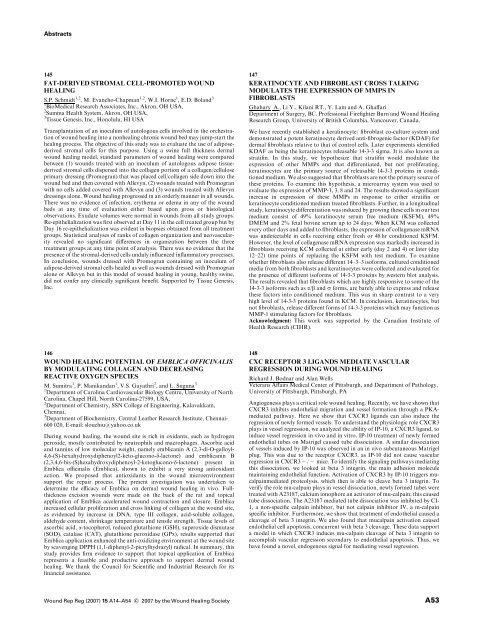

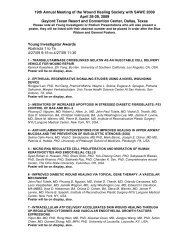

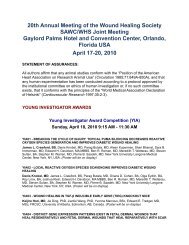
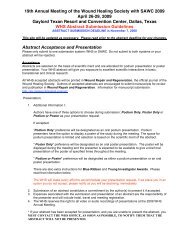
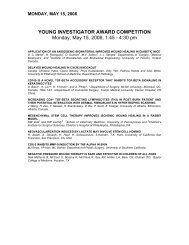




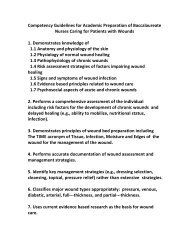
![2010 Abstracts-pah[2] - Wound Healing Society](https://img.yumpu.com/3748463/1/190x245/2010-abstracts-pah2-wound-healing-society.jpg?quality=85)